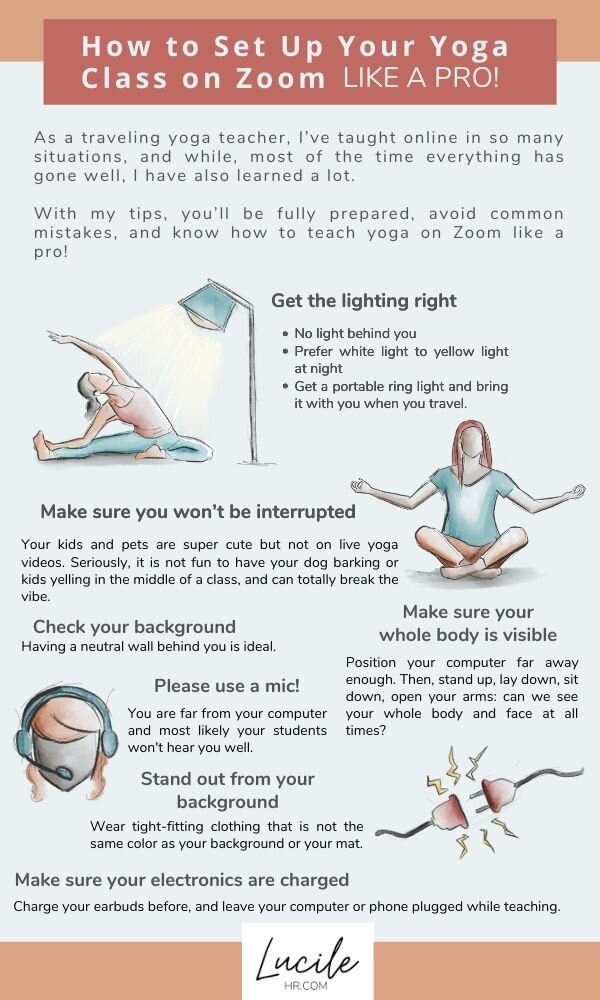How to Teach Yoga on Zoom
Worried about messing up your next Zoom yoga class?
With a bit of preparation, you can stand out from the crowd when teaching yoga online and give an incredible experience to your students, one that’s even more valuable than going to a studio.
So keep reading for the best tips for teaching yoga on zoom (and other live yoga platforms!)
As a traveling yoga teacher, I’ve taught online in so many situations, and while, most of the time everything has gone well, I have also learned a lot.
Seriously, be ready for anything happening, I had a cat fall from the ceiling in my room in Bali and was recently (lightly) electrocuted with studio lights in Paris. Don’t worry, with my tips, you’ll be fully prepared, avoid common mistakes, and know how to teach yoga on Zoom like a pro!
Table of Contents
1. Set up like a pro:
Get the lighting right
Follow these simples rules to radically improve your online yoga teaching experience:
No light behind you
Prefer white light to yellow light at night
Get a portable ring light and bring it with you when you travel.
Make sure you won’t be interrupted
Your kids and pets are super cute but not on live yoga videos. Seriously, it is not fun to have your dog barking or kids yelling in the middle of a class, and can totally break the vibe. Have them in another room or have someone else take care of them during your class.
Check your background
Having a neutral wall behind you is ideal. In any case, please clean up and remove clutter as even leaving one forgotten sock can make the experience less relaxing for your students.
Make sure your whole body is visible
Position your computer far away enough. Then, stand up, lay down, sit down, open your arms: can we see your whole body and face at all times?
Please use a mic!
You are far away from the camera, no one can hear you! That is the single most important thing you need to remember, and an easy way to improve your zoom yoga classes: get a mic.
The best microphone to teach yoga online needs to be:
Bluetooth (you are moving)
Safely secured to either your ears or head (you are moving)
Stand out from your background
Wear tight-fitting clothing that is not the same color as your background or your mat. Bright colors work well, I’ve recently switched mats to get the Jade in Fire Engine Red.
Make sure your electronics are charged
Charge your earbuds before, and leave your computer or phone plugged while teaching.
2. Test it out
Record a quick video
Set up your room and record a fast video of you talking and moving when you are in a new space or testing out new settings. I do mine in PhotoBooth on my Mac, so it is really easy to do
Wifi speed test
Bookmark this page, and check what the numbers mean here.
Have some backup wifi like the hotspot on your phone.
Test the zoom link and retest audio and video
Just click on the link and make sure everything works at least 5 minutes before
3. Use the right settings
Whatever platform you use for your online yoga class, you’ll want to do these:
Mute everyone as a default
Turn off your notifications
Disable the waiting room: you might not see latecomers waiting to join your class after it has started
Be mindful of music: don’t play music next to you with speakers, either send them the playlist or
Avoid zoom bombing and not getting paid: only give the link to students that have signed up, take attendance, and add a password
Don’t forget to record your classes if you’re planning to reuse them
4. Get feedback
To keep improving your class, just ask your students! This is the best way to learn how to teach a yoga class on zoom.
Here are a few best practices I use as an online yoga teacher:
Ask if everyone can hear and see you at the beginning: this will avoid you teaching a full class only to realize people can’t see you very well!
Ask questions: During class ask if everyone has understood or seen something you are demonstrating, ask them for a thumbs up (or a message in the chat) if all is good or a wave if they need a further explanation.
Check the chat: sometimes people write stuff in the chat like “we can’t hear you”. You do not want to miss out on this.
Go the extra mile: Ask a trusted student or friend for detailed feedback on our set up after class
5. Safety first
Help your students safely manage their space:
Tell them where they should put their props and give them replacements if they don’t have common yoga props.
Tell them if there’s something they should know to make the pose safer like, “don’t do an inversion next to a window or a mirror but at a wall”
Ask about injuries or limitations before class and teach accordingly
People can also send you a message privately if they are not comfortable disclosing it to everyone. Do not forget to include options for this limitation in the class, without singling out the person. Think “if you have a shoulder injury do this” rather than “Laura, you can’t do this pose”.
Encourage students to listen to their bodies
Even more than in IRL classes, talk about how the pose should feel, not how it looks! Since you are doing the class with them, students could be tempted to do exactly what you do: demonstrate different options and use supportive language: “You might want to do this, or this. We are all different so find the option that works for you today.”
Know common issues in poses and ways to modify
When you are confident about your alignment, it is easier to know what your students always do that doesn’t serve them.
A few examples could be:
Keeping their legs straight in downward facing dog if their lower spine is rounded
Trying to put the feet higher up the leg in tree pose and ending placing it on the knee
Anticipate these issues and offer modifications. If you are currently learning how to teach yoga online, taking time to watch your students will help you a great deal.
6. Connect with your students
Teaching yoga online is a wonderful opportunity to serve more people and connect with students that would not have gone to a studio class otherwise. You are bringing so much value to others and you should be aware of it!
Here are a few zoom yoga class tips I use to connect with my students on a deeper level:
Give them the option to turn their camera on: And actually watch them and show them you do! Give them vocal adjustments. Don’t force everyone to have their camera on as not everyone is comfortable with that.
Participate: Do the whole class with them or introduce workshop elements where students can ask questions in the chat.
It’s actually an audio class: Make your instruction so clear that they don’t have to look at you all the time and can flow with your words.
Have fun and let your personality shine: This is just yoga! So whatever happens, keep it fun and don’t take yourself seriously. The best way to teach yoga online is the one you enjoy!
I hope you enjoyed this article and that you feel equipped to be the best online yoga teacher you can be! Zoom is one of the best platforms to teach yoga online but this works with any online class, live or recorded. So keep experimenting to find what works for you!




